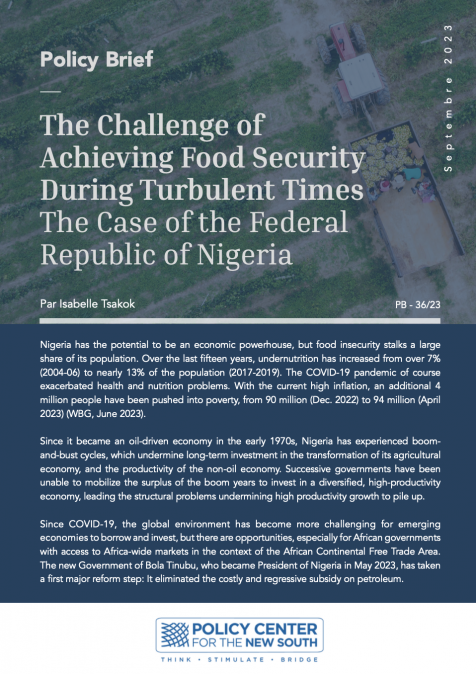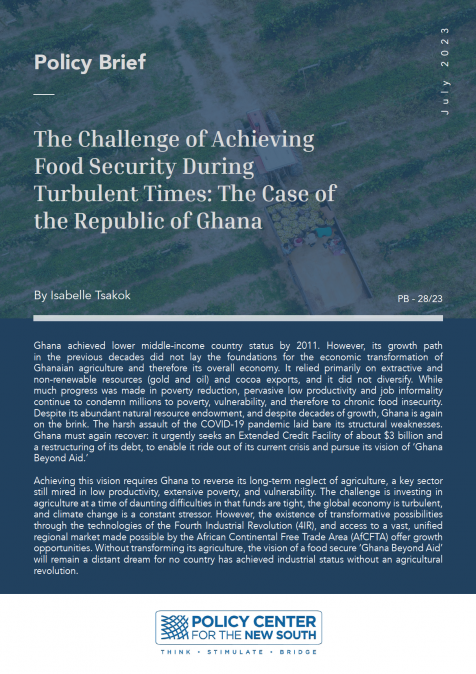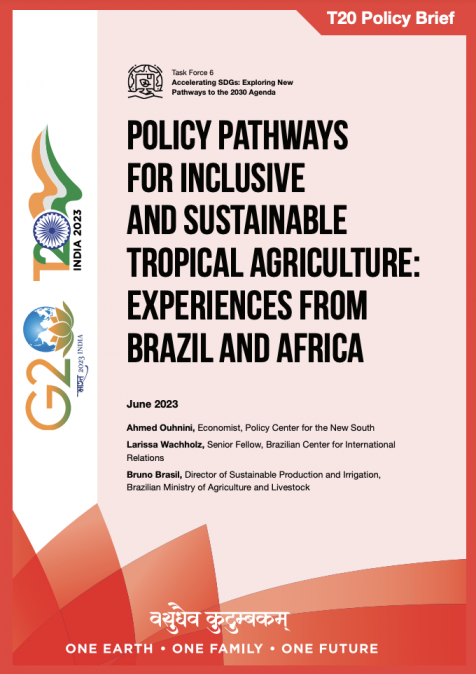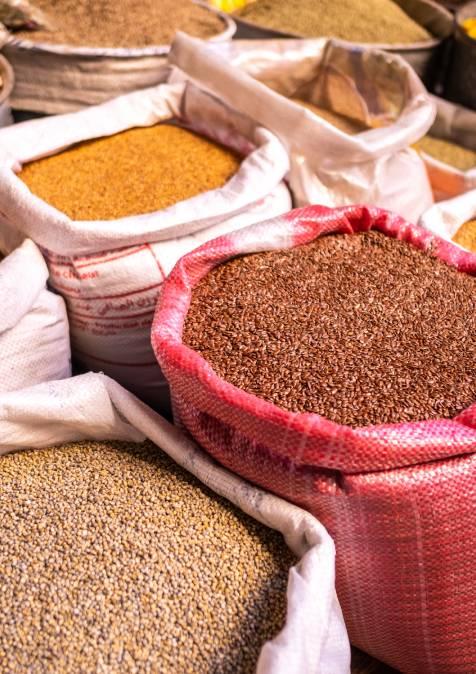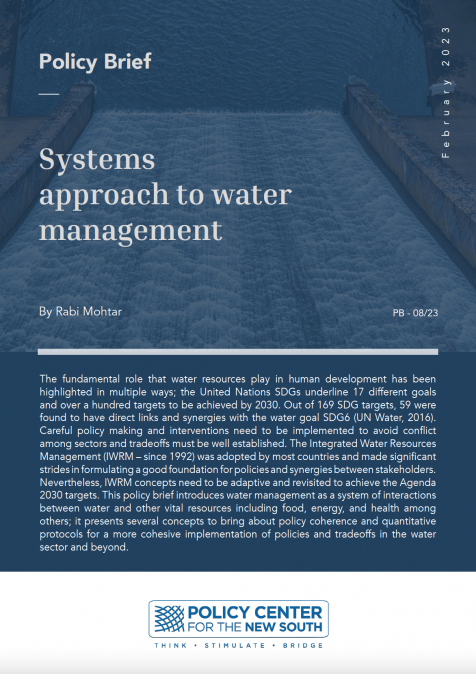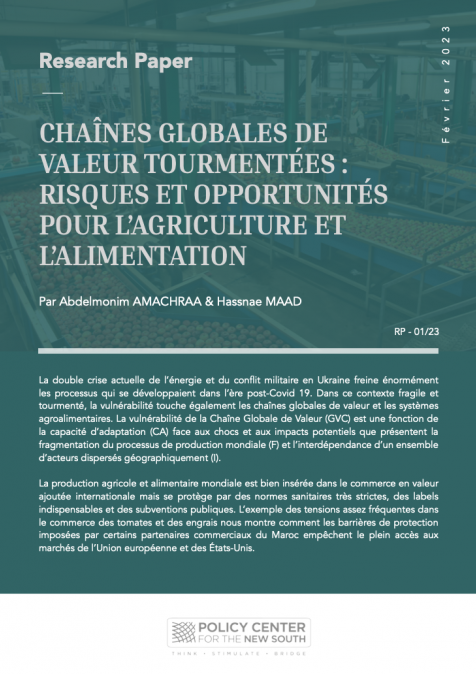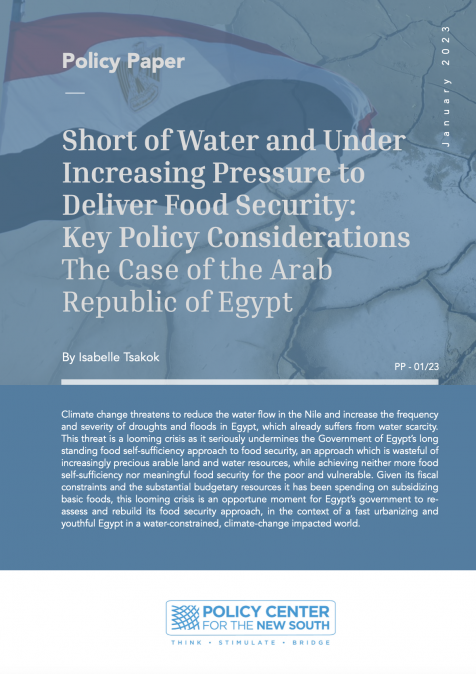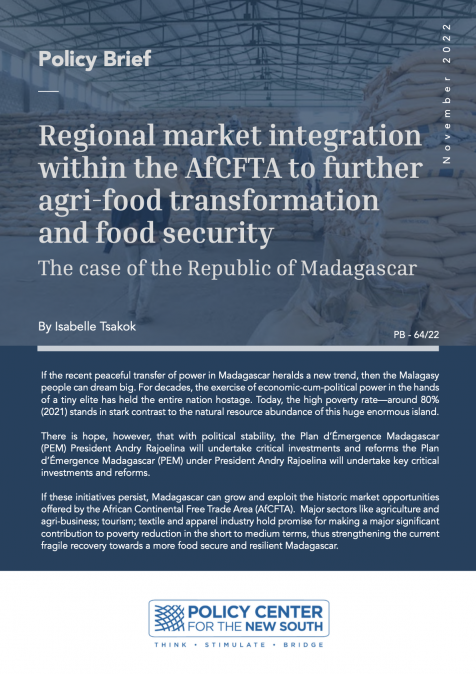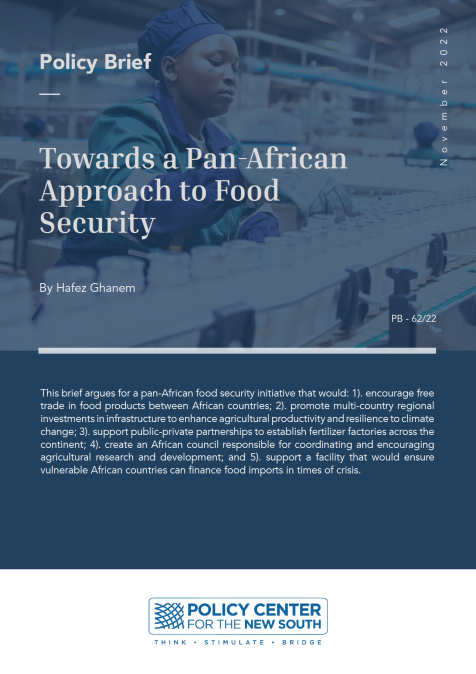Publications /
Policy Brief
Nigeria has the potential to be an economic powerhouse, but food insecurity stalks a large share of its population. Over the last fifteen years, undernutrition has increased from over 7% (2004-06) to nearly 13% of the population (2017-2019). The COVID-19 pandemic of course exacerbated health and nutrition problems. With the current high inflation, an additional 4 million people have been pushed into poverty, from 90 million (Dec. 2022) to 94 million (April 2023) (WBG, June 2023).
Since it became an oil-driven economy in the early 1970s, Nigeria has experienced boom- and-bust cycles, which undermine long-term investment in the transformation of its agricultural economy, and the productivity of the non-oil economy. Successive governments have been unable to mobilize the surplus of the boom years to invest in a diversified, high-productivity economy, leading the structural problems undermining high productivity growth to pile up.
Since COVID-19, the global environment has become more challenging for emerging economies to borrow and invest, but there are opportunities, especially for African governments with access to Africa-wide markets in the context of the African Continental Free Trade Area. The new Government of Bola Tinubu, who became President of Nigeria in May 2023, has taken a first major reform step: It eliminated the costly and regressive subsidy on petroleum.
Introduction
The Federal Republic of Nigeria (Nigeria for short) is often referred to as the Giant of Africa. The term ‘giant’ is apt in at least two senses.
1- In terms of its population: Nigeria’s population is around 213.8 million (2021), the largest in Africa, with a growth rate of 2.6% per year (high fertility rate of around 5.2 births per woman (2021))[1]; the population is also young, with a median age of around 18 years old (UNFPA).
2- Despite its low economic growth rate (2015-19), Nigeria is the largest economy in Africa. It is endowed with abundant natural (e.g., oil and gas, hydropower, vast land resources, 78% and 37% of which is agricultural and arable[2], and marine fisheries) and human resources (e.g., a large and vibrant youth population) (WBG, June 2019).
However, these considerable assets have proven to be a mixed blessing. Heavy dependence on its oil and gas sector has generated three main problems. First, it has made Nigeria dependent on, and therefore vulnerable to, volatile commodity prices. Crude oil and natural gas revenues have dominated the balance of payments and government finances since the early 1970s[3]. Thus, Nigeria has experienced boom-and-bust cycles following the ups and downs of oil prices: boom (1971-84), bust (1985-99), boom again (2000-14), then downturn again (since 2015), despite high oil prices in 2021. Second, Nigerian agriculture inevitably suffered from the Dutch disease—an overvalued currency, the naira[4]. Third, with Nigeria’s high population growth rate and youth bulge, the non-oil economy has not been able to generate sufficient, high productivity, formal-sector jobs.
The former Government of Muhammadu Buhari had the goal of lifting 100 million Nigerians out of poverty by 2030[5]. This daunting goal is now for the new government to reach. In his inaugural speech on May 29, 2023, President Bola Tinubu promised to unify the nation, create opportunities for all, restructure the economy, strengthen security, and create jobs. To the extent that he succeeds, he will vastly improve the food security of Nigerians, who now still suffer from a poverty rate of over 40%[6]. In addition, there are major spatial disparities between north and south with recurrent and violent ethnic conflicts[7], and disparities between growing urban areas and isolated rural areas, and between pastoralists and farmers, in the fertile Middle Belt, and in the North West, Nigeria’s poorest region.
This Policy Brief analyzes the nature of the challenge of achieving food security during these turbulent times. Like in Ghana, the predominance of oil has been both a blessing and a curse[8]. This Policy Brief first sets out key features of the global and national context within which Nigeria must meet the challenge of achieving food security.
The basic question is: within this turbulent global environment, and given the opportunities for growth offered by transformative technologies of the Fourth Industrial Revolution (4IR) and the African Continental Free Trade Area (AfCFTA), what challenge does Nigeria face to achieve food security? “From a macro perspective, the two main drivers of food security, are household incomes and food prices” (Timmer, 2015). Simply put, Nigeria’s challenge is to raise household incomes, and supply food at affordable prices. The successful transformation of agriculture is central to achieving both.
At the outset, we should be clear about what achieving food security means. “Food security exists when all people, at all times, have physical and economic access to sufficient, safe and nutritious food that meets their dietary needs and food preferences for an active and healthy life” (World Food Summit, 1996). Food self-sufficiency[9] and food sovereignty,[10] at best, can contribute to, but cannot be equated to, food security.
The Global Context: Global Crises Keep Piling up But There are Transformative Technologies
A tense global environment riddled with crises: Crises influencing the food-security situation include
1- Supply-chain dislocations triggered by the COVID-19 pandemic, deepening economic distress and economic uncertainty the world over;
2- Russia’s war on Ukraine, which has inflicted food and fertilizer inflation, hurting poor countries the most, several of which were already reeling from domestic conflict, natural disasters, and severe hunger;
3- Costly government responses to counter the health and economic impacts of COVID-19. By 2021, an estimated 58% of the world’s poorest countries were in debt distress or at high risk of being so (World Bank Blog, June 2022). This has heightened the risk of global financial instability;
4- Growing geopolitical tensions between Western democracies—NATO with the United States and Russia over its invasion of Ukraine; between China and the United States over Taiwan and islands near Japan, and in the South China seas;
5- Growing trade protectionism and deglobalization fragmenting world trade;
6- Large numbers of refugees fleeing[11] (i) collapsing governments and political persecution; (ii) gang violence, economic deprivation, and years of drought; (iii) natural disasters, conflict, and lack of economic opportunities; and (iv) war. According to the UNHCR, an estimated 108.4 million people were forcibly displaced at the end of 2022.
7- Worsening of global hunger, even before the pandemic. Russia’s decision (July 17, 2023) to exit the Black Sea Grain Initiative is the latest blow that could deepen hunger. [12] Thus, the prevalence of undernourishment (PoU) jumped from 8% to 9.3% of world population (2019-20), and to 9.8% in 2021 (FAO, 2022). In the outlook for the October 2022-January 2023 period, FAO-WFP warned of further deterioration of acute food insecurity in 19 countries, countries referred to as Hunger Hotspots[13].
These crises are all occurring against the background of accelerating climate change with more frequent and more extreme weather events, such as droughts, floods, wildfires, and landslides, further undermining food security.
The potential of the Fourth Industrial Revolution (4IR) technologies—disruptive but transformative[14]: A bright spot is the transformative power of the technologies of the 4IR, still being realized in countries, typically of higher incomes, which have invested in them. Building on the computer[15] and the digital revolution from the 1950s to the 2000s, the technologies of the 4IR are distinguished by interconnectivity and communication between machines, sensors, people, and various devices, by the huge amount of data they collect and process to inform and facilitate decision-making, and by the speed with which these processes take place. These technologies include:
- The iPhone or smartphone
- The Internet of things (IoT)
- Artificial intelligence (AI) or machine learning (ML)
- 3D printing
- Robotics
- Blockchain
- Augmented (AR) and virtual reality (VR)
- Driverless cars or fully autonomous vehicles
- Nanotechnology
- Biotechnology
These technologies are correctly referred to as ‘disruptive’ because business as usual must adapt and change. Thanks to these technologies, ‘smart’ factories are no longer the realm of science fiction; sensors can detect impending equipment failure and help remove it until it is repaired and fit for production again. In transportation and logistics, fleets of trucks, cars, ships, trains can be rerouted based on up-to-date weather conditions, vehicle, and driver availability. In agriculture, digital technology can be used to substantially reduce the cost and improve the quality of research and extension services essential for promoting climate-smart techniques among smallholders. These techniques are essential for them to adapt and thrive in a world affected by climate change.
Investment in physical and human capital essential for exploiting the potential of 4IR: The widespread adoption of these technologies has become a major factor dividing higher- and lower-income economies. Humans need to be in charge to harness the power of these machines. Governments, private business, households, and individuals must be empowered to understand and utilize the productive potential of these 4IR machines. A daunting challenge for lower-income countries is how best to mobilize the funds required to make investments in the physical and human capital that is needed. This challenge is front and center for highly-indebted, developing countries where sustained productivity growth is essential. One proposal to address this challenge is the ‘Debt Relief for Climate Initiative’, under which debt reduction would be linked to financing investment in climate adaptation and mitigation initiatives (Canuto et al, 2023). Nigeria is not highly indebted, but debt servicing (public and publicly-guaranteed debt) nevertheless reached 40% of GDP in 2022 (WBG, June 2023). Thus, its revenue and expenditure structure has been problematic in terms of investing in long-term productivity growth, which is threatened by climate change, including in agriculture and agri-business, which are key for diversification and for achieving food security.
Nigeria: GNI/Cap: USD 2,140 (Current $. 2021. Atlas method)[16] (WDI)
Oil Wealth: A Blessing or a Curse?
Selected socio-economic features of an agriculture-dominant Nigeria in the 1950s: After 20 years of prospecting by the Shell-B.P. Petroleum Development Company of Nigeria, Ltd., oil was finally discovered in Nigeria in Oloibiri, Bayelsa State, in 1956, when the country was still a British protectorate[17]. There was no estimate of national poverty, but incomes were low, with average per-capita income at around GBP 24, which at that time was less than the levels in Liberia and Ethiopia. In Nigeria, there were also major regional income disparities[18] (World Bank, April 1958). Before Nigeria joined OPEC in 1971, smallholder subsistence agriculture was the dominant sector, contributing around 67% of GDP, and 90% of exports, and providing livelihoods for 80% of the population of around 34 million. Farm cultivation was mainly manual, rarely using ox-drawn ploughs. Inter-cropping was extensive, and so was leaving the land fallow for 3-5 years, which was critical for maintaining soil fertility given that fertilizer was hardly used. Starchy staples (e.g. root crops) dominated food crops. Livestock (cattle, goats, and sheep) production was undertaken mainly by the nomadic Fulani tribe and was primarily limited to the tsetse-free areas of the North. The main export crops were palm oil and palm kernels, cocoa, groundnuts, cotton, and timber, all purchased and exported through five statutory marketing boards, one in each of the four major regions, and a Central Marketing Board.
Agriculture, low productivity and uncompetitive, in an oil-dominant Nigeria in the twenty-first century: By the 2010s, oil and gas contributed 90% of exports, and over 70% of federally collected revenues[19], although their contribution to GDP has fallen to about 10% (WBG, June 2019). Thus, since 1971, the contribution of agriculture to GDP has been decreasing to average around 22% of GDP (2010s). Despite its plentiful agricultural resources, food imports accounted for some 10% of total national imports by the 2010s (World Bank, 2013). By 2020, the food import ratio had risen from 10% to 14% (IMF, Feb 2023) Agriculture’s role in employment has remained high at above 70% of Nigeria’s population, although there has been an inverse relationship between the fall in agricultural employment and the rise of oil prices. Thus, agricultural employment fell when oil prices rose during 1971-1984, rose when oil prices fell during 1985-99, fell when oil prices rose again during 2000-14, and rose again during 2015-21 The ups and downs in oil prices have contributed to macro instability, widespread corruption despite anti-corruption efforts[20], an inimical policy environment for private investment, and an over-valued currency, which has undermined the competitiveness of Nigerian agriculture. Contrast Nigeria’s management of its oil wealth with Norway’s. The Government of Norway built a sovereign oil fund which is managed by the Central Bank of Norway, which has to report regularly to the Norwegian parliament (Norges Bank, 2015)[21]. Norway has succeeded in using its oil wealth to grow into a high-income, food-secure country. Nigeria, however, is still saddled with low-productivity agriculture and extensive food insecurity. Over the past two decades, value added per capita in agriculture has risen by less than 1% per year, and yields, especially of the main staple crops, remain well below potential (WBG, June 2019). Agriculture is primarily rainfed, despite abundant water resources which have largely not been harnessed through irrigation[22]. Farms remain small (80% are less than 5 hectares; about half of smallholders have less than one hectare), with limited access to improved inputs and technologies. In addition to the negative macro- and trade-related factors, the growth of agricultural productivity has been undermined by structural problems including:
1- land-tenure insecurity contributing to frequent land conflicts between communities;
2- poor transport, communications, and marketing infrastructure contributing to underdeveloped agricultural value chains and food-processing activities; and
3- limited access to financing, marketing information, and markets. The African Continental Free Trade Area (AfCFTA; signed by Nigeria in 2019) offers a vast regional market to Nigeria, but to make profitable access a reality depends, at a minimum, on Nigeria removing trade barriers (e.g., import bans, border closures, and foreign-exchange restrictions) and developing infrastructure.
Climate change and environmental degradation a major threat to agriculture and the broader economy: Nigeria is classified as one of the ten most vulnerable economies to the impacts of climate change and natural disasters. Climate-induced shocks have become more frequent and more pronounced. In particular, the arid northern savanna ecosystems are being damaged by searing temperatures. Nigeria’s major sectors are climate-sensitive: oil and gas extraction, agriculture, and forestry. Unfortunately, Nigeria has comparatively few systems to protect its assets against natural hazards. Deforestation, large-scale land clearance, and floodplain encroachment mainly for agriculture, have resulted in severe environmental degradation. An estimated 90% of the total land area suffers from some form of soil erosion, with around 6% (6000 sq. km) severely degraded. Soil erosion removes fertile top soil, contributing to reduced agricultural productivity, siltation of water bodies and flooding, severe gully erosion in the south, and desertification in the north[23], contributing to conflict in the North East. Nigeria’s extensive coastline (853 km) and abundant marine resources also suffer from erosion, flooding and saltwater intrusion, mangrove depletion, and inundation of wetlands. The costs are high: marine coastal restoration is estimated to cost $1.6 million per hectare (WBG, June 2019). If business-as-usual persists, that is climate-change inaction persists, Nigeria could lose between 2%-11% of GDP by 2020, and 6%-30% of GDP by 2050, equivalent to a loss of $100 billion to $460 billion (WBG, Nov 2020).
The Challenge of Achieving Food Security During Turbulent Times
Even during ‘good’ times, structural factors undermined food security: During 2000-14, oil prices were high, and Nigeria’s annual growth averaged 7%. Poverty decreased but at a slow rate. According to the NLSS[24] (2018-19), 40.1% of Nigerians (82.9 million people) were living below the national poverty line. An additional 25.4% of Nigerians (52.6 million) were vulnerable—for this group, their consumption levels were between the poverty line and 1.5 times the poverty line—to falling into poverty when faced with shocks to their incomes. Nigeria’s fertility, stunting, infant and child mortality rates, and maternal mortality ratios are among the highest in the world, while life expectancy is among the lowest (WBG, June 2019). Although income inequality is low, with a Gini coefficient at 0.35, there are sharp spatial income disparities between north and south. Poverty is primarily rural—84.1% live in rural areas, with 76.1% living in the North Central, North East, or North West. Food insecurity is worst in the north, which is most affected by violence (WBG, Nov 2020). Key factors undermining food security are found at individual, group, and nationwide levels. These include:
1- The annual population growth rate remains stubbornly high at 2.6% (or a Total Fertility Rate (TFR) of 5.3). This high fertility rate is itself partly an outcome of social norms which include: (i) early marriage—nearly 24% of girls age 14-19 are already married, and 19% in that age group are already mothers or pregnant with their first child; (ii) millions of adolescent girls are out of school, either as dropouts or they never enrolled[25]; and (iii) pronounced gender gaps in basic and secondary education. These gaps constitute a major divide between north and south.
2- Low public spending on education and health at 1.7% of GDP, compared to the sub-Saharan Africa average of 4.7% of GDP (WBG, Nov 2020). This low investment in human capital is a major impediment in an age when the use of transformative technologies requires a healthy labor force with extensive training and skills. Low public investments in human capital contribute to low labor productivity, widespread informality in the labor market, and labor ill-equipped for the skills needed for a dynamic modern economy. In addition to the low productivity in the agriculture and rural sectors, productivity is also low among firms. Only 58% of firms are formal, below the average of 84% in the rest of sub-Saharan Africa.
3- The low human capital investment in Nigeria’s young people—23% of the population—currently 41 million, projected to rise to 84 million by 2050—undermines their health and productivity. Nigeria has the sixth lowest human capital index (HDI) in the world[26]. At 0.36, it means that a Nigerian child born today will be 36% as productive in adulthood as he/she could be if he/she enjoyed complete education and good health in his/her early years. For those in the working age group (15-35), unemployment was nearly 30% in 2018 (WBG, Nov 2020).
4- Widespread infrastructure gaps—in e.g., transportation, irrigation and storage, power supply for industry and households, potable water supply and sanitation services[27]—not only undermine private investment and economic growth, but also basic health and nutrition. The poor health outcomes in turn undermine productivity, strengthening the vicious circle between poverty and low productivity. The infrastructure gap is estimated to reach $3 trillion over the next 30 years, which would require annual investments of $100 billion (WBG, Nov 2020).
5- Weak public sector governance and institutional disfunction: The oil-revenue sharing agreement between the federal and state governments is complex and is considered a major factor leading to weak public-sector governance, which includes: (i) poor intra- and inter-governmental coordination at different levels of government and between federal and state levels; (ii) ineffectiveness of government administration and the delivery of services; and (iii) non-transparent and unaccountable management of public resources; simply put: widespread corruption. An example is the management of Nigeria’s periodic influxes of oil revenues in stark contrast to the way Norway has chosen to use the economic rent from its large oil and gas revenues to build long-term wealth to benefit the Norwegian population, not just the mining companies and current politicians.
6- The above structural problems have inevitably undermined growth. Low growth has in turn sharpened the competition over resources, fueling violent conflicts (e.g., between pastoralists and farmers), insurgent attacks (e.g., Boko Haram in the North East/the Lake Chad area), and other forms of violence (e.g. 95% of maritime kidnappings in the first half of 2020 occurred in the Gulf of Guinea, mainly in Nigerian waters)[28]. According to Worldwide Governance Indicators, and the Global Peace Index, Nigeria ranks in the bottom 10% of all countries in terms of political stability, and the absence of violence and terrorism (WBG, Nov 2020).
The challenge of achieving food security during these turbulent times: The global environment has considerably worsened with the Russian invasion of Ukraine (since Feb. 2021), the high food and fertilizer inflation which ensued, the tightening of monetary policy worldwide to contain the inflation, which in turn has increased the cost of borrowing, and the decline in long-term growth prospects if current trends continue (WBG, 2023)[29]. Nigeria has one of the highest inflation rates: the Consumer Price Index accelerated in 2023 up to 22.4% (WBG, June 2023). Nigeria’s GDP per capita growth rate was only 1.1% in 2021. Sluggish growth predated the pandemic (2015-19). Even when oil prices rose by over 150% from 2020 to 2022, Nigeria’s fiscal space shrunk instead of improving, with the general government deficit at or above 5% of GDP since 2021. This is because of Nigeria’s costly petrol (also called Premium Motor Spirit or PMS) subsidy[30], which absorbs Naira 4.5 trillion or 2.2% of 2022 GDP; and because of a protracted decline in oil production (WBG, June 2023).
Mobilizing investment funds for diversification, a central challenge: Thus under these more difficult external and domestic circumstances, the challenge of achieving food security is how to mobilize resources to make long overdue investments, including (i) diversifying away from oil by building a more productive, climate-smart agriculture (crops and livestock), adaptive and resilient to climate change; (ii) improving access to markets, domestic and regional, through AfCFTA; (iii) rebuilding the human capital of the poor and vulnerable in terms of social protection and their access to basic health, sanitation, and education services; empowering girls and women, in particular, since they are currently severely disadvantaged through social norms, with virtually no control over their life decisions; and (iv) investing in the education and skills training of the labor force (male and female), especially the burgeoning youth population, so they can use transformative 4IR technologies and participate in a dynamic and inclusive economy.
Conclusion: Nigeria is at a Crossroads…
The good news is that the new Nigerian Government of President Tinubu has taken a major step to put Nigeria on a promising road to recovery and to transition to a more diversified, resilient, inclusive, and prosperous Nigeria, all essential to a being a food-secure Nigeria. It eliminated the costly and wasteful PMS subsidy and continued to reform the foreign exchange regime. The bad news is these are only a start, albeit a vital start. With climate change posing an existential threat to millions, the urgency of addressing the food security challenge cannot be overstated.
Bibliography
- Canuto, Otaviano, Hinh T. Dinh, Karim El Aynaoui, Hafez Ghanem, Badr Mandri. June 20, 2023. External Debt Management in Africa: A Proposal for a ‘Debt Relief for Climate Initiative’. https://www.policycenter.ma/publications/external-debt-management-africa-proposal-debt-relief-climate-initiative.
This policy brief was originally published on T20 India website
- Council on Foreign Relations. https://www.cfr.org/boko-haram
- International Monetary Fund (IMF) Feb 16, 2023. Nigeria: Selected Issues. https://www.elibrary.imf.org/view/journals/002/2023/094/article-A001-en.xml
- Norges Bank. April 14, 2015. “Managing Norway’s Oil Wealth”. Speech by Governor Oystein Olsen at FeBAF, the Italian Banking, Insurance, and Finance Federation, Rome, 2015. https://www.norges-bank.no/en/news-events/news-publications/Speeches/2015/2015-04-14-Olsen-Roma/#:~:text=Over%20the%20past%20two%20decades,the%20central%20bank%20of%20Norway.
- Tsakok, Isabelle. July 2023. “The Challenge of Achieving Food Security during Turbulent Times: The Case of the Republic of Ghana.” Policy Center for the New South, PB – 28/23. https://www.policycenter.ma/sites/default/files/2023-07/PB_28_23%20%28Tsakok%29.pdf
- United Nations Fund for Population Activities ((UNFPA); called United Nations Population Fund in 1987) World Population Dashboard Nigeria. https://www.unfpa.org/data/world-population/NG
- Wikipedia. April 6, 2020. Human Capital Index. 2020. https://en.wikipedia.org/wiki/Human_Capital_Index
- Williamson, Timothy. Dec 01, 2021. History of Computers: A brief Timeline. https://www.livescience.com/20718-computer-history.html
- World Development Indicators (WDI). Fertility Rate, Total (Births per woman). Most recent year, 2021. https://data.worldbank.org/indicator/SP.DYN.TFRT.IN?locations=NG
- World Development Indicators (WDI). GNI/cap. Atlas Method. 2021, 2022. https://data.worldbank.org/indicator/NY.GNP.PCAP.CD?locations=NG
- World Bank. April 18, 1958. The Economy of Nigeria. Report # EA-79. https://documents1.worldbank.org/curated/en/168411468099258074/pdf/multi0page.pdf
- World Bank. 2013. Toward Climate-Resilient Development in Nigeria. Editors: Cervigni, Raffaello, Ricardo Valentini, and Monia Santini. Directions in Development. https://documents1.worldbank.org/curated/en/707851468100141797/pdf/Toward-climate-resilient-development-in-Nigeria.pdf
- World Bank. March 2016. The Nigeria Fadama National Series: How to Build a Pilot into a National Program through Learning and Adaptation. https://documents1.worldbank.org/curated/en/276351467990996530/pdf/The-Nigeria-Fadama-National-Development-Series-How-to-Build-a-Pilot-into-a-National-Program-Through-Learning-and-Adaptation-Delivery-Case-Study.pdf
- World Bank Group (WBG) June 2019. Moving towards a Middle-Class Society--Nigeria on the move: A Journey to Inclusive Growth- A Systematic Country Diagnosis. https://openknowledge.worldbank.org/server/api/core/bitstreams/0dce44c3-b003-5028-9b71-df082494adf6/content
- World Bank Group (WBG) Nov 16, 2020. Country Partnership Framework for the Federal Republic of Nigeria for the period FY 21-25. Report No. 153873-NG. https://documents1.worldbank.org/curated/en/526171611619063445/pdf/Nigeria-Country-Partnership-Framework-for-the-Period-FY21-FY25.pdf
- World Bank Group (WBG) Dec 2022. Nigeria Country Economic Memorandum: Charting a New Course—Synthesis Report. https://documents1.worldbank.org/curated/en/099020012132216124/pdf/P1761970c336260ce0bd0e0ebd98a53275d.pdf
- World Bank Group (WBG) June 2023. Nigeria Development Update. Seizing the Opportunity. https://documents1.worldbank.org/curated/en/099062623065078024/pdf/P17990608d087c05f0868f041fca331108b.pdf
- World Bank Group (WBG) 2023 Falling Long-term Growth Prospects: Trends, Expectations, Policies—Advance Edition. Edited by Ayhan Kose and Franciska Ohnsorge. https://openknowledge.worldbank.org/server/api/core/bitstreams/fe0880d1-ffbf-430f-bab4-d3dbdda7470e/content
[1] The fertility rate in sub-Saharan Africa is 4.6 births per woman (2021) (World Development Indicators (WDI)).
[2] Compare these ratios to 42% agricultural and 9% arable land for sub-Saharan Africa as a whole (World Bank Group, (WBG), June 2019).
[3] Nigeria started producing oil in the late 1950s. As a % of merchandize exports, oil rose from 3% (1960) to 43% (1969), and to above 90% by 1974 (WBG, June 2019).
[4] The term ‘Dutch Disease’ was coined by The Economist magazine in 1977, in reference to the Netherlands discovering vast gas deposits in the North Sea in 1959. The good news of this discovery led to a large influx of foreign exchange, which raised the value of the domestic currency, the Dutch Guilder. This rise then made non-oil Dutch exports less competitive on the world market, hurting the competitiveness of the non-oil sectors in the Netherlands. Similarly, the influx of foreign exchange into Nigeria undermines the competitiveness of agricultural and other non-oil exports. The overvalued Naira encourages imports. Thus, the broader non-oil Nigerian economy suffers.
[5] The Buhari Government served from May 2015 to May 2023. President Bola Tinubu of the All Progressives Congress assumed office in May 2023. Tinubu, a Yoruba, was formerly governor of Lagos.
[6] Nigeria has the dubious distinction of having the second-largest population of poor in the world (WBG, Nov. 2020).
[7] Home to a multi-ethnic and culturally diverse population, with more than 400 ethno-linguistic groups. This diversity has contributed to severe socio-economic conflicts, including but not limited to the Boko Haram insurgency in the north east.
[8] Ghana was discussed in a recent Policy Brief, ‘The Challenge of Achieving Food Security During these Turbulent Times: The Case of the Republic of Ghana’, (PB 28-23, PCNS, July 2023).
[9] Singapore is a prime example: it is not food self-sufficient—it imports much of its food—but it is food secure. Its GNI/cap is US $ 64,010 (Current $; Atlas method). See https://data.worldbank.org/indicator/NY.GNP.PCAP.CD?locations=SG.
[10] Food sovereignty is concerned about the rights of the people who produce the food and is against the power of multinationals in agriculture and food related firms. Thus: “Food sovereignty is the right of peoples to healthy and culturally appropriate food produced through sustainable methods and their right to define their own food and agriculture systems”, La Via Campesina (World Food Summit, 1996).
[11] For example, as (a) in Venezuela, Myanmar, and Afghanistan; (b) in Central America; (c) from sub-Saharan Africa into Europe; and (d) in Syria and Ukraine.
[12] As of Sept 05, 2023, there is no definite resolution yet. Turkish President Tayyip Erdogan’s talks with Putin on Sept 4 in Sochi on this blockade announced that grain shipments can resume soon, but no date was given. Putin’s conditions still need to be met. Talks are also ongoing between Russia and some African states on exporting Russian grain.
[13] The Hotspot countries include: Afghanistan; Ethiopia; Nigeria; South Sudan; Somalia; and Yemen. They are at the highest alert level. Other countries of very high concern are all in the Global South: in sub-Saharan Africa, the Middle East, Latin America and the Caribbean, and Asia. They are: the Central African Republic, Democratic Republic of Congo, Kenya, Malawi, the Sahel Region, Sudan, Madagascar, Zimbabwe, the Syrian Arab Republic, Guatemala, Honduras, Haiti, Pakistan, and Sri Lanka (FAO-WFP outlook).
[14] This term “disruptive technologies” was first used by German economist, founder and Executive Chairman of the World Economic Forum (WEF, 1971), Klaus Schwab. This term closely resembles the famous phrase by Joseph Schumpeter in his Capitalism, Socialism and Democracy (1942) of “creative disruption”.
[15] A brief history of the major inventions in computing is presented in History of Computers: A brief timeline (Williamson, 2021).
[16] Nigeria is classified by the World Bank as a lower middle-income country. For country income classifications in U.S. $ (last update July 1, 2022), see https://blogs.worldbank.org/opendata/new-world-bank-country-classifications-income-level-2022-2023.
[17] Nigeria gained independence from the British Crown on October 1, 1960.
[18] The West (including Lagos) was relatively better off, at GBP (Great Britain Pound) 36; the North less than 50% of the West, thus GBP 18; and in the East GBP 28 (World Bank, April 1958). In addition to these income disparities, there have always been serious ethnic conflicts among the three broad groups: the Yoruba in the West, the Igbo in the East, and the Hausa-Fulani in the North. Spread out among 250 tribes, tribal loyalties remained strong, especially in the Muslim north.
[19] These are revenues that are collected centrally by the federal government and paid into the federation account for distribution to the three tiers of government.
[20] According to Transparency International’s Corruption Perception Index, Nigeria has been consistently ranked among the lowest 30% of countries (WBG, June 2019). In contrast, Norway scored 84 (2022) on a CPI ranging from 0 (very corrupt) and 100 (very clean). Its public sector is perceived as the most honest.
[21] It is instructive to contrast Nigeria’s and Norway’s management of their oil and gas wealth. Norway discovered vast oil and gas reserves in 1971. National leadership decided that the reserves belong to the Norwegian people, current and subsequent generations, not only to the companies or the political elite. The government created a sovereign oil fund: the Government Pension Fund Global, or oil fund for short, managed by the Central Bank of Norway. The Ministry of Finance is responsible for the oil fund, the management of which has to follow principles and strategy overseen by the Norwegian parliament (Norges Bank, April 2015). When Norway discovered the petroleum reserves, its per-capita GNI was relatively low compared to the rest of Europe. Its GNI per capita reached $95,510 in 2022 (WDI). The comparison with Norway clearly shows that oil or any mineral wealth need not be a curse.
[22] Small-scale irrigation was developed in the context of a series of projects: FADAMA (I), (II) and (III), from 1992 for 20 years. Fadama is a Hausa-Fulani name for irrigable land, usually low-lying plains underlaid by shallow aquifers found along major river systems (World Bank, March 2016).
[23] About 351,000 hectares of land is lost to desertification every year in the northern regions (WBG, June 2019).
[24] NLSS: National Living Standards Survey.
[25] According to the Nigeria Living Standards Survey (NLSS) 2019/2019, approximately 57% of girls aged 15-19 are out of school in Northern states (North East + North West + Niger state) (WBG, Nov. 2020).
[26] The Human Capital Index is an annual measurement estimated by the World Bank. The index varies between 1 (the highest potential) and 0 (the lowest). As a comparison to Nigeria, the highest HCI for 2020 was Singapore at 0.88; the lowest is Niger at 0.29 (Wikipedia, Human Capital Index, last edited April 6, 2023).
[27] Some 56% of all Nigerians lack basic sanitation services. Nigeria is about to overtake India as having the largest population of open defecators in the world (WBG, Nov. 2020).
[28] Nigeria is among the top five countries in the world in the kidnapping of foreign nationals.
[29] According to WBG (2023), there was already a global productivity slowdown in the decade before COVID-19. Since then, other major drivers of growth are also weak: investment growth, a slow down in the growth of the global labor force combined with reversals in human capital investment, and slower growth in international trade, which used to be twice GDP growth during 1990-2011 but is now barely as high as GDP growth.
[30] The subsidy benefited mainly the better-off classes as only 3% of the poor purchased this subsidized PMS.

